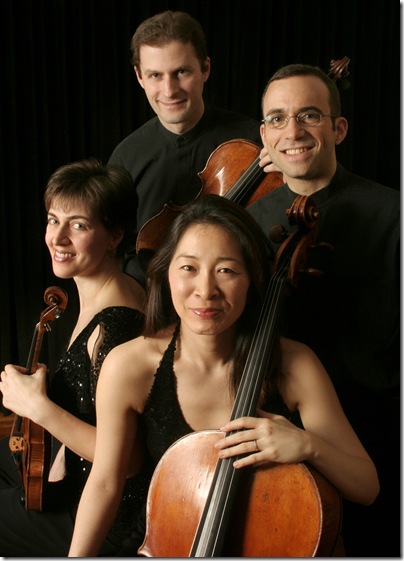In Yaron Zilberman’s film A Late Quartet, which came out in 2012, the soundtrack recording of the Beethoven Op. 131 quartet was played by the Brentano String Quartet, and there were appearances in the film by the actual Brentano cellist, Nina Lee.
Newly named the quartet in residence at the Yale School of Music, the Brentanos — violinists Mark Steinberg and Serena Canin, violist Misha Amory, and cellist Lee — were in our neighborhood Sunday for a return appearance at the Society of the Four Arts. Beethoven was again their calling card, along with a rarity, the lone string quartet of Edward Elgar.
The first half of the concert featured Beethoven’s Quartets Nos. 3 (in D, Op. 18, No. 3) and 11 (in F minor, Op. 95, Quartetto Serioso), the first from his first, Haydnesque collection, and the second a transitional piece to the sublime weirdness of the late quartets. From the initial seventh that opens the Third Quartet, the Brentanos played with a sheen of phenomenal smoothness and an intimate kind of elegance that gave the music almost a melting quality, as if it were spun of the lightest materials and folding into itself.
The opening Allegro (with the repeat) came off at a good clip, not the post-Sunday brunch leisurely tempo at which serene late 18th-century music like this is frequently offered. In the development section, the quality of the Brentanos’ ensemble was clear in the seamlessness of the triplets traded from instrument to instrument, and while the sudden dynamic shifts Beethoven so loved were in their proper places, they were emphasized rather than hammered.
In the second movement (Andante con moto), one of those notational nightmares with every possible small-value note thrown into the mix, the tempo was nice and steady, the big 32-note runs like swatches of silk, and the mood again calm and not particularly fervent. Clarity and clean execution were the order of the day for the third movement (with a nice change of color at the minor-key trio), and the headlong Presto spotlighted some outstanding rapid playing by each of the members of the quartet, with a sly wink in the hushed final bars.
It was an immaculate performance of this remarkable early work of Beethoven, though I don’t think the exceptional quality of this reading overall would have been harmed with some stronger contrasts, particularly in the slow movement and the finale.
The Brentanos saved some of those fireworks for the Quartet No. 11, which came next. This is a strange, brilliant piece of music that also is written along dramatic lines, with shocks to the system providing added interest. The primary material is relatively simple from a fundamental standpoint, but it’s written furiously, with a big, buzzing outburst at the beginning and wide, broken vistas opening up thereafter.
Here, too, the Brentanos were in full control of their performance, setting up the architecture of the first movement with crisp attention to the central motif, and following that with an urgent, tense reading. But here again, the scalar rockets that interrupt the forward motion, while beautifully played, were almost too polished. A greater sense of surprise, of instant fire, would have helped.
The almost experimental second movement, with its obsessive fuguing and quiet downward scales in the bass, was played very quietly, and the fugal section itself had an austerity and dryness to it that sounded studious and inward-looking. Keeping the three-quarter pulse is absolutely essential to the third movement, and the quartet did that very well, which helped the frequent violent stops and starts hang together and contrast with the almost stress-less contrasting trio music.
The finale had the same breathless drive as the Egmont music, which is from this same time (1810) and in the same key, and the compressed major-key coda appeared out of nowhere, like a line of troops suddenly appearing over the hill, and the effect was splendid.
For the second half, the Brentanos chose the String Quartet of Edward Elgar, written in his favorite key of E minor and very much in his late manner, elusive and somewhat remote in a Brahmsian way, with a hard-to-define loveliness.
The Brentanos’ ability to create a flawless sonic texture served them well with this music, too, which has a seething kind of internal unrest. Emotions were held in check, with the focus on making Elgar as beautiful as they could make him. The quartet was adept in the second movement at bringing off a mood of nostalgia and regret, with touches of a relaxed fullness amid the sweet modal primary material.
The finale’s many moods were carefully unfolded as part of a larger narrative arc, and the quartet brought some real fire to the closing pages of the movement, nervous, angry music reflecting Elgar’s anguish over World War I and the end of everything the composer held dear. It’s not remotely easy to bring off, but the Brentanos make mighty impressive work out it, as indeed they did for the Beethoven quartets on the first half.
This is a masterful ensemble that can play very different works with complete technical assurance and a deep understanding of what the music is all about. It’s also evident that these are musicians who have been working together a long time; it’s hard to see how they could achieve such a flexible but unified sound had it been otherwise.
Next up in the Four Arts chamber music series is the Calder Quartet of Los Angeles. They’ll play music by Mozart (Quartet No. 14 in G, K. 387), Schubert (the Death and the Maiden quartet), Webern (Five Movements, Op. 5), and Vexed Man, by film composer Don Davis. The concert is set for 3 p.m. Sunday at the Gubelmann Auditorium; tickets are $20. Call 655-7226 or visit www.fourarts.org.
